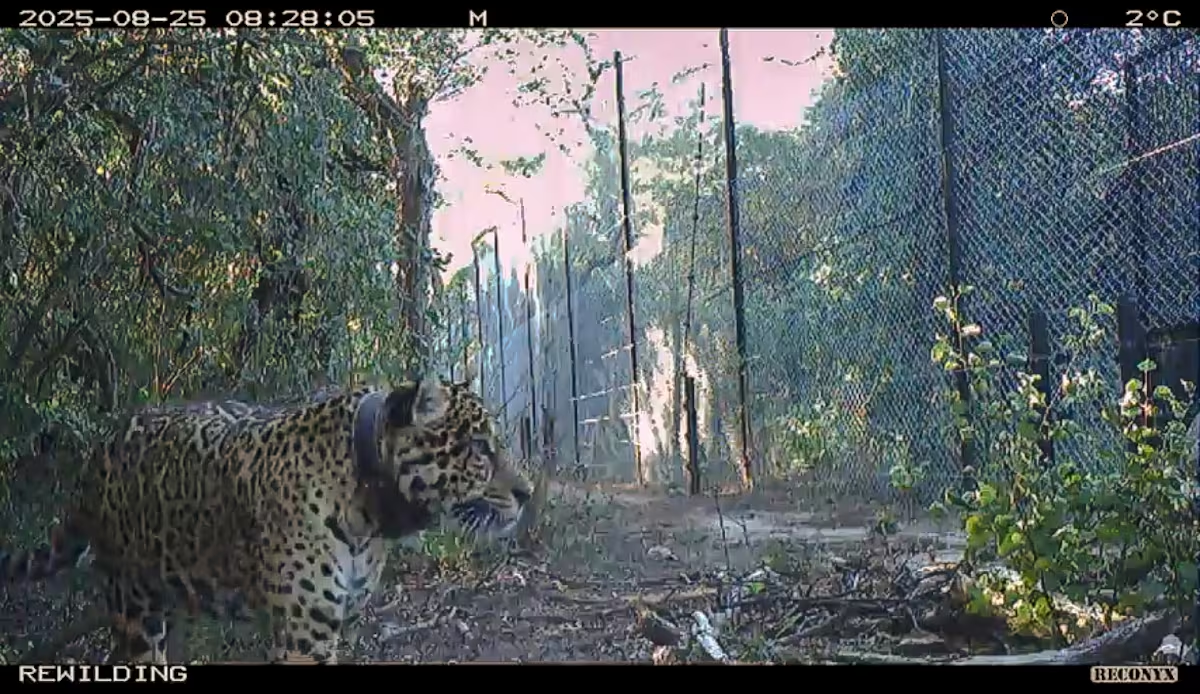
this Monday they left the jaguar for dead was released in El Inviolable National Parklocated in Chaco state. His name was Acai and he was less than three years old. She was born on February 28, 2023, and was finally released on October 5, but her freedom did not last long. No animal remains have yet been found. The only thing found was a geolocator collar, and the last satellite signal was recorded on October 25th. The device currently lies at the bottom of the Bermejo River.
“There are two possibilities. One is that Acai is on the bottom, but we all know that her body is floating. The most likely one is that someone killed her, took off her collar and threw her into the water,” explained Sebastian Di Martino, conservation director of the Rewild Argentina Foundation, one of the scientists who accompanied the female from birth to release.
The National Park Service filed the complaint last week with the Criminal Secretariat of the Federal Court of Roque Sáenz Peña in Chaco. The Federal Prosecutor’s Office has intervened in the case, and police are conducting a search operation. Although no official conclusion has been reached, investigators have assured that Mr. Asai was murdered and that they have proof. “A suspect has already been identified,” they said.
Chaco governor Leandro Zdero published a message on social networks, writing: “If the facts are confirmed, the state will become the plaintiff. We took part in the release of Acai a few days ago, and we also participated in the reintroduction of the jaguar in the Chaco Mountains a few days ago. There will be no punishment for those who attacked the symbol of our fauna.”
Like many residents, the president suspects one or more people hunted the feline. “We will oppose those responsible and those responsible,” he added. Those at the Rewilding Foundation share that hypothesis.

“On September 28, several messages and publications began to appear on social networks warning about the dangers jaguars present, stating that national parks do not have trained personnel and therefore endanger the population. They were all anonymous complaints, some even signed by ‘park neighbors’,” Di Martino said. These publications were reproduced in local media and were accompanied by anonymous publications that spoke about alleged attacks on people without evidence.
Di Martino connects these messages to several incidents that occurred in the area. Acai hunted two calves and attacked a dog. “But even the owners of the dogs mentioned in these publications revealed that it was their pets who attacked them first,” he says.
For him, like other conservation experts, the idea that jaguars are a threat to humans is completely unfounded. No attacks on humans have been recorded for decades, and these animals generally flee from human presence.
“Jaguars will not attack people unless harassed. Jaguars prefer wild prey to domestic animals. If attacks on livestock occur, they can be avoided by better herd management, as is already the case for some residents of El Impenetrable,” the Rewild Argentina Foundation explained in a statement.
October 25th was the last day the Acai collar’s GPS recorded movement near the Bermejo River. Then the satellite signal was interrupted. After careful ground and air surveys, they were able to locate the device using short-range VHF radio signals, which are more stable than satellite signals. The necklace was found submerged in the Bermejo River and is currently being recovered.
The jaguar is South America’s largest cat, but its presence in Argentina is becoming increasingly rare. The population declined significantly throughout the 20th century. At that time, trophy hunting was popular, and “tiger” existed. Today, their causes of death are different but equally severe in terms of habitat loss due to deforestation and human persecution.
Deforestation of native forests destroys the environment in which these animals find food and shelter, forcing them closer to residential areas, where they become easy targets for fear and anger. Hunters don’t always kill felines. People who see cats near their homes or fear for their livestock may kill them. And sometimes all it takes is a fake video or exaggerated story about an alleged attack to spread on social media to cause a wave of panic.
Fear, although often unfounded, occupies a central place in the narratives that justify the hunting of these animals. They are stories that have morphed over time, but keep alive the false idea that Yaguarete is the enemy of humanity. However, there are no records of attacks against people not provoked by previous attacks.
Yaguarete has been declared national natural monument Argentina enjoys the highest level of legal protection. Hunting is prohibited and carries heavy fines and prison sentences. It is also recognized as a protected species in the states where it still exists, including Misiones, Salta, Jujuy, and Chaco.
“There are only about 200 specimens left in the country, and that number is not increasing because they continue to be killed,” Di Martino warned. “In Salta and Jujuy, the population has decreased, and in Misiones province, Iguazu and Yaboti regions, only one male remains,” he added.
from Rewinding Argentina Foundation They regretted that jaguar hunts continued to occur frequently. The remaining populations in the jungles of the country’s northeast and northwest continue to decline due to poaching, the expansion of agricultural frontiers, and the loss of biological corridors that allow migration and reproduction.
The acai incident has reignited debate about the coexistence of humans and large carnivores in a region where livestock expansion, illegal logging, misinformation and conservation efforts coexist. His death, which has not yet been confirmed but is almost certain, is a symbolic and biological blow to a project seeking to restore balance to one of the country’s most degraded ecosystems.
Acai was part of an ambitious plan to reintroduce jaguars to El Impenetrable, where they went extinct more than half a century ago. The story should be a step towards the restoration of the landscape and its original fauna. But its abrupt end is a reminder that beyond scientific efforts, the survival of big cats also depends on society’s ability to overcome fear and assume coexistence with nature.



